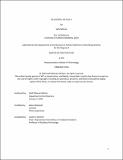Bleeding Details
Author(s)
Mohan, Sahil
DownloadThesis PDF (15.83Mb)
Additional downloads
Advisor
Modesitt, Adam
Terms of use
Metadata
Show full item recordAbstract
This thesis begins at my Nani Ji’s house. Movies depicting Hindu mythology played in the background of our family gatherings- movies where Hanuman would grow to the size of a mountain or Shiva would morph between genders. These shifts between scale, gender, and material affirmed the queerness I had yet to find words for. They taught me that boundaries expand and contract. Everything was interconnected. I could be a mountain. This preoccupation with Hindu Gods led me to their home: Mount Meru. Hindu, Jain, and Buddhist cosmologies consider this sacred five-peaked mountain to be the center of all physical. Metaphysical, and spiritual universes among other centers. Religious anecdotes imply that the Hindu-Kush Himalayan Ice Sheet is this focal point. And the Ice Sheet sustains a complex history: a history of water in its many forms, a history of religious diversity and spiritual importance, a history of war and boundaries. Boundaries drawn like a line. And so too, architecture continues to occupy itself with the line. It considers and abstracts an ideal future by drawing precise lines that separate buildings from environment. This abstraction may be necessary for the field, but it leads to a fixation on strategies of centering segregation, precision, and predictability. Drawings have become a passive instrument of information. They imply an impossible neutrality which produces objects that endure, rather than bodies that engage their contexts. But a world assembled by determined moments and perfectly fixing parts could harbor no life. Nothing could move or become. What if the methods of architecture reflected the flow of water or the fluidity of human embodiment? This thesis is as much a question as it is an answer. Can architecture cross and blur boundaries and binaries: queer and heteronormative, land and water, human and nature? When and how would it all dissolve? What happens to architecture when the details bleed?
Date issued
2024-02Department
Massachusetts Institute of Technology. Department of ArchitecturePublisher
Massachusetts Institute of Technology